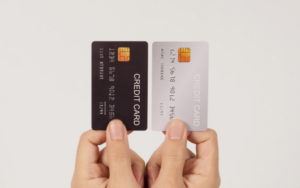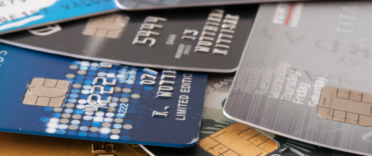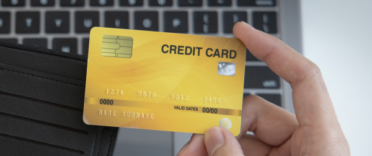 You can switch credit cards to get a better interest rate on an existing balance, access a different type of credit card, earn more rewards on your spending or increase your credit limit. Whatever your reason, it is important to make sure that the credit card switch benefits your finances and does not risk debt problems or damage your credit score. In this article, we explain how to switch credit cards and why you may want to switch, plus our top tips to avoid any potential pitfalls.
You can switch credit cards to get a better interest rate on an existing balance, access a different type of credit card, earn more rewards on your spending or increase your credit limit. Whatever your reason, it is important to make sure that the credit card switch benefits your finances and does not risk debt problems or damage your credit score. In this article, we explain how to switch credit cards and why you may want to switch, plus our top tips to avoid any potential pitfalls.
How to switch credit cards
Here are the steps to follow in order to make the most of switching your credit card:
1. Pick the right type of card
The perfect credit card for one person could be the worst credit card for someone else. Focus on your financial circumstances and what you want your credit card to do for you. That could be helping consolidate your debt, offering you cashback on your purchases or reducing the interest you're paying on existing credit card debt. This can help you find a credit card with the features to fit your needs, whether that means an initial 0% purchase rate, low balance transfer fees or valuable rewards. We go into more detail in our article ‘Which credit card is best for me?’.
2. Check your eligibility
In most cases, you can find out how likely you are to be accepted for a credit card without filling out a full application and undergoing a hard credit check. Checking your eligibility is an important part of a credit card switch because you will want to avoid making too many applications, which can damage your credit score and make future borrowing more difficult. Once you have an idea of which credit cards you will be able to successfully apply for, you can make a more informed decision on the best option to go for.
You can use Money to the Masses partner Creditec* to quickly build a list of the credit cards that match up with your needs. By simply adding in a few basic details, you will get a tailored collection of the best credit cards for you. You can use your Creditec results to check how likely you are to be accepted for a certain card, which cards available to you offer the best rewards or find out what option will leave you with the lowest fees to pay. Creditec is able to check your eligibility without running a full credit check, which means your credit score will not be affected. Click this link to start your comparison*.
3. Check your credit score
Checking your eligibility will give you a clue as to how highly you are rated as a potential borrower by credit card companies. You can gain further insight by checking your credit score. We cover how to do this for free in our article ‘The best way to check your credit score for free’. You will be able to dispute any mistakes and make sure the information on your credit file is correct. A good credit history that suggests you are a reliable borrower will boost the range of credit cards you are able to get and improve the interest rates and deals you are offered. If you have a low credit score, there are some simple steps you can take to increase it. We explain more in our article ‘How to improve your credit score quickly’.
4. Compare credit card deals
Now that you know what credit cards you are likely to get and how to improve your chances of accessing the best rates, it is time to compare the best deals on the market. A seemingly small difference in the APR, balance transfer fee or 0% interest period could make a huge difference to the overall cost of using the card. You can find the top credit cards in our ‘Best credit cards in the UK’ article.
5. Make sure your new deal is better than your old one
Don’t be drawn in by the excitement of a shiny new credit card without making sure that you are getting a better deal with your new credit card than your existing one. The most obvious time to switch credit cards will be at the end of an offer period, especially if you can access a similar deal on a new card. However, if you are switching for better rewards or a new 0% interest period, make sure to think about what would happen if you do not clear the balance before any interest-free period ends. You should also check the small print to make sure you are eligible for the offer you are expecting. Keep in mind that the representative APR you see advertised may not be the exact APR you are offered. We explain more in our article ‘What is representative APR?’.
6. Apply for a new card
This is the stage at which you will need to fill out a full application and undergo a hard credit check. You can apply for most credit cards online and find out if you have been successful or not very quickly, if not instantly. In some cases – such as if you are applying for a card from a high street bank or building society – you could choose to go to a physical branch to complete your application and talk to someone in person.
7. Use your new card
Once your card arrives in the post you will need to follow your new provider’s instructions to activate it. You can then use it for your intended purpose, whether that be a balance transfer, a new purchase or a money transfer. Your new credit card provider will explain how to find out what the card’s PIN is and how to change it, which is usually a good idea with a new card for security reasons.
8. Decide whether to cancel your old card
You will next need to decide if you want to keep your old card or not. A well-maintained credit account will usually look good on your credit file, though having too much available credit could make borrowing additional money more difficult. Conversely, using a large percentage of your available credit could suggest that your finances are spread too thin, so you may want to keep old lines of credit open. If you choose to cancel your old card, you will need to contact the provider and clear or transfer the balance. Once your account is cancelled, cut up your card and any additional cards to make sure they are not used accidentally.
Top reasons to switch credit cards
If your existing credit card is no longer working for you or doesn’t fit in with your current financial situation, you may find that the best option is to switch to a new one. Here are some reasons why you may want to start looking for a new credit card:
- The 0% balance transfer period has ended - Balance transfer credit cards usually offer an initial 0% interest period for a limited time. Once this period ends, the rate of interest you need to pay on your balance can increase quite sharply. While you should always budget to pay off the debt before the offer ends, a credit card switch could be a money-saving alternative. You can find the best balance transfer credit cards in our ‘Best 0% balance transfer credit card deals’ article.
- The 0% period purchase period has ended - Some credit cards will come with an introductory interest-free period on purchases. Once this ends and you have cleared the existing balance, it may be a good idea to switch to a new card offering a similar deal for future purchases. We cover the top options in our ‘Compare the Best 0% purchase credit cards’ article.
- The introductory fee offer has ended - Many credit cards charge an annual fee just to have the card, no matter what level of spending you use it for. In some cases, the credit card provider will waive the fee for an initial period, usually the first year. Once this period ends and you have to start paying a hefty fee every year, you may find that the card is not worth keeping and it would make more sense to switch credit cards to a fee-free option.
- You want to consolidate credit card debt - If you already have outstanding balances on multiple credit cards, you could look to consolidate your debt through a balance transfer credit card. This can simplify your repayments and save you money on interest. Read our article ‘What is the best way to consolidate my debt?’ for more details. You could also check out our ‘Where to get free debt advice’ article if you are struggling with your credit card repayments.
- You want to get a better purchase rate - Spreading the cost of a purchase over several months could mean paying a considerable amount of interest if you do not have a 0% purchase credit card. This is because of the purchase rate credit card providers charge on your spending. We explain more in our article ‘What is a credit card purchase rate and how can it affect your options?’. Switching to a card with the lowest possible purchase rate – preferably a 0% purchase card – will help you save on spreading the cost of a purchase over multiple months.
- You want a lower balance transfer fee - A balance transfer usually involves a balance transfer fee, calculated as a percentage of the balance being transferred. If your existing card has a high balance transfer fee, you could consider switching to a credit card with no fee. You can find the top balance-transfer credit cards with no fee in our ‘Best 0% balance transfer credit card deals’ article.
- You want to access rewards and cashback - Spending on your credit card can help you earn rewards and cashback. This could be a simple percentage back on your card spending or points that you can exchange for vouchers or rewards. The more you spend, the more you earn – which can create the temptation to overspend. However, you will get the best value out of this type of credit card by spending as you otherwise would. A credit card switch could help you start earning rewards or cashback, or upgrade your existing card. We have the best deals in our ‘Compare the best cashback and reward credit cards’ article.
- You want to use your credit card for free abroad - Another reason for a credit card switch is to save money on spending abroad. Many credit card providers will charge foreign transaction fees and charge you for taking out cash, but there are some that do not. Alternatively, you could keep your existing credit card and spend abroad in a different way. We cover both options in our ‘Compare the best travel credit cards’ article.
- You want to borrow more money - Not all credit card providers will offer you the same credit limit, so you may find that switching to a different card means that you can borrow more money. There are risks to borrowing more money, so you will need to make sure you can afford to pay more than the minimum payment on whatever you purchase. We explain why this is so important in our article ‘What is the minimum payment on a credit card?’. If you have been using a credit-builder card to improve your credit score, you may find that there are now more options available to you that include higher credit limits.
Top tips for switching credit cards
Here are some of our top tips to follow when you switch credit cards:
- Make sure the numbers add up - Your credit card switch should make your financial situation better. If the new credit card does not offer better terms than your existing card, then switching would likely be of little benefit. For example, the balance transfer fee on a new card could potentially outweigh the savings of switching to get a lower interest rate. You will only know for sure by applying the relevant figures to your finances.
- Do your research - A credit card is not always the best option. Read our articles ‘Credit card vs debit card: Which should you use and when?’ and ‘Is it better to get a credit card or a personal loan?’ to check that a credit card suits what you want to use it for.
- Monitor your credit score - A credit card application will involve a hard credit check, which will leave a mark on your credit file and could temporarily reduce your credit score. If you plan to apply for any borrowing in the near future – such as a mortgage – it may not be the right time for a credit card switch.
- Clear your old balance - It is easier to switch credit cards if you have cleared the balance on your existing card. This will not be an option if you are applying for a balance transfer credit card, but for other credit cards it removes the risk of interest building up on a forgotten credit card.
- Limit your new applications - Too many applications in a short period of time can damage your credit score and affect your future borrowing potential. You can use an eligibility checker to see what credit cards you are likely to be successful in applying for and avoid damaging rejections.
- Close your old account fully - Clearing your balance and getting a new credit card does not mean you can forget about the old one. You will need to contact your provider and cancel the card, then cut it up.
When not to switch credit cards
A credit card switch will not suit everyone. For example, if you have only recently applied for a new credit card, you should avoid adding further applications to your credit file. Every credit card application will involve a hard credit check, which leaves a footprint on your credit file. Too many in a short period of time can damage your credit score and make it harder to borrow money in the future, as lenders may think you are struggling to manage your finances. Maintaining long-standing accounts can also be a way to boost your credit score by building a history of reliable borrowing and timely repayments.
You should also think twice about switching credit cards if you already have an existing balance that you are struggling to repay. Moving to a 0% balance transfer credit card can be a great way to cut the cost of your debt, but you will need to be able to budget for repaying the balance before the offer period ends. In some cases, applying for credit when you are already in debt can make matters worse and lead to a debt spiral. If you have any questions about managing your debt, reach out to one of the free, independent organisations listed in our ‘Where to get free debt advice’ article.
Getting an additional credit card
One alternative to switching credit cards is to get a new credit card but keep your old one. The main risk of taking on additional credit cards is that it will increase the amount you can borrow and potentially increase the risk of falling into serious debt. However, this could be a suitable option if it would mean you have two different types of credit card – such as a balance transfer credit card and a rewards credit card, or a purchase credit card and a money transfer credit card. In that scenario, you would use the cards for different purposes and so limits the risk of overspending on multiple cards.
If a link has an * beside it this means that it is an affiliated link. If you go via the link Money to the Masses may receive a small fee which helps keep Money to the Masses free to use. But as you can clearly see this has in no way influenced this independent and balanced review of the product.






